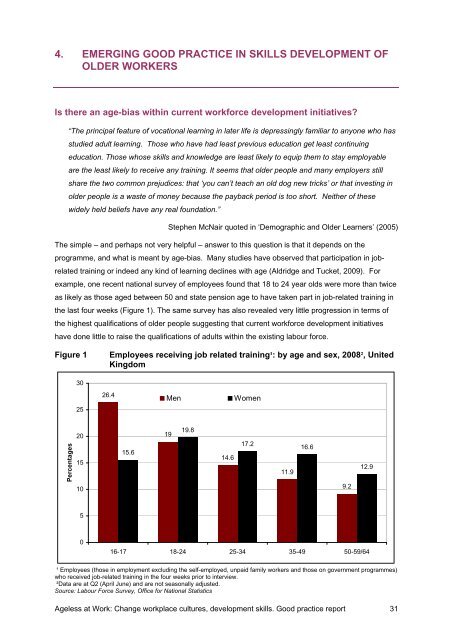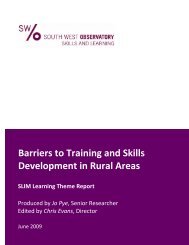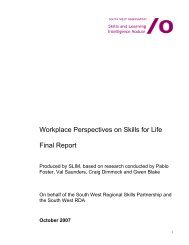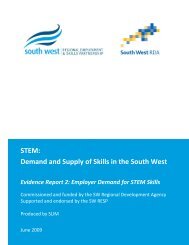Ageless at Work - Skills for Care
Ageless at Work - Skills for Care
Ageless at Work - Skills for Care
You also want an ePaper? Increase the reach of your titles
YUMPU automatically turns print PDFs into web optimized ePapers that Google loves.
4. EMERGING GOOD PRACTICE IN SKILLS DEVELOPMENT OF<br />
OLDER WORKERS<br />
Is there an age-bias within current work<strong>for</strong>ce development initi<strong>at</strong>ives?<br />
“The principal fe<strong>at</strong>ure of voc<strong>at</strong>ional learning in l<strong>at</strong>er life is depressingly familiar to anyone who has<br />
studied adult learning. Those who have had least previous educ<strong>at</strong>ion get least continuing<br />
educ<strong>at</strong>ion. Those whose skills and knowledge are least likely to equip them to stay employable<br />
are the least likely to receive any training. It seems th<strong>at</strong> older people and many employers still<br />
share the two common prejudices: th<strong>at</strong> ‘you can’t teach an old dog new tricks’ or th<strong>at</strong> investing in<br />
older people is a waste of money because the payback period is too short. Neither of these<br />
widely held beliefs have any real found<strong>at</strong>ion.”<br />
Stephen McNair quoted in ‘Demographic and Older Learners’ (2005)<br />
The simple – and perhaps not very helpful – answer to this question is th<strong>at</strong> it depends on the<br />
programme, and wh<strong>at</strong> is meant by age-bias. Many studies have observed th<strong>at</strong> particip<strong>at</strong>ion in jobrel<strong>at</strong>ed<br />
training or indeed any kind of learning declines with age (Aldridge and Tucket, 2009). For<br />
example, one recent n<strong>at</strong>ional survey of employees found th<strong>at</strong> 18 to 24 year olds were more than twice<br />
as likely as those aged between 50 and st<strong>at</strong>e pension age to have taken part in job-rel<strong>at</strong>ed training in<br />
the last four weeks (Figure 1). The same survey has also revealed very little progression in terms of<br />
the highest qualific<strong>at</strong>ions of older people suggesting th<strong>at</strong> current work<strong>for</strong>ce development initi<strong>at</strong>ives<br />
have done little to raise the qualific<strong>at</strong>ions of adults within the existing labour <strong>for</strong>ce.<br />
Figure 1<br />
Employees receiving job rel<strong>at</strong>ed training¹: by age and sex, 2008², United<br />
Kingdom<br />
30<br />
26.4<br />
Men<br />
Women<br />
25<br />
Percentages<br />
20<br />
15<br />
10<br />
15.6<br />
19<br />
19.8<br />
14.6<br />
17.2<br />
11.9<br />
16.6<br />
9.2<br />
12.9<br />
5<br />
0<br />
16-17 18-24 25-34 35-49 50-59/64<br />
¹ Employees (those in employment excluding the self-employed, unpaid family workers and those on government programmes)<br />
who received job-rel<strong>at</strong>ed training in the four weeks prior to interview.<br />
²D<strong>at</strong>a are <strong>at</strong> Q2 (April June) and are not seasonally adjusted.<br />
Source: Labour Force Survey, Office <strong>for</strong> N<strong>at</strong>ional St<strong>at</strong>istics<br />
<strong>Ageless</strong> <strong>at</strong> <strong>Work</strong>: Change workplace cultures, development skills. Good practice report 31








